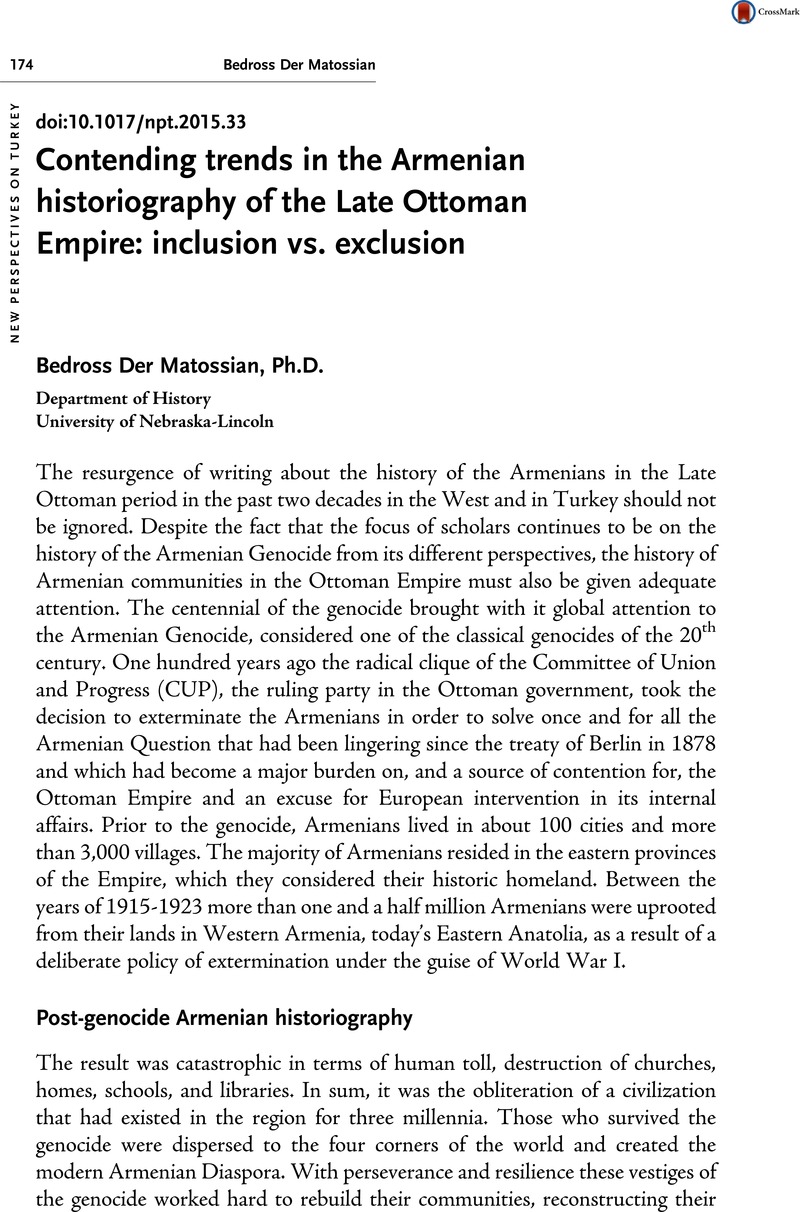Published online by Cambridge University Press: 30 December 2015

1 Sanjian, Avedis K., “Armenian Works on Historic and Modern Armenian Communities,” in Report on Current Research on the Middle East (Washington, D.C.: Middle East Institute, 1958), p. 49Google Scholar.
2 Karayan, Sarkis, “Histories of Armenian Communities in Turkey,” Armenian Review, Issue 33, Number 1, 1980, 89-96Google Scholar.
3 Haig, Vahe (Haig Dindjian), Kharpert yev anor Vosgeghen Tashduh [Kharpert and Her Golden Plain] (New York, [s.n.], 1959)Google Scholar.
4 Harnpartsoumian, VahanKughash’kharh: Badmagan Askakragan Ousoumnasiroutiun [Village World: An Historical and Cultural Study of Govdoon] (Paris, Daron Press 1927)Google Scholar.
5 For the list of the Interwar period works see Karayan, , “Histories of Armenian Communities in Turkey,” pp., 90-91Google Scholar.
6 See his work on Srpuhi Dussap, Krikor Zohrab, Minas Cheraz, Patriarch Torkom Kushagian, Patriarch Kirkor Gesaratsi, and Archbishop Ghevont Tourian.
7 Alboyadjian, Arshag, Badmoutiun Hay Gesario [History of Armenian Caesaria] (Cairo, 1937)Google Scholar, 2 Vols.
8 Idem, Badmoutiun Yevtogio Hayots [History of Armenians of Tokat] (Cairo, Nor Asdgh Press, 1952)
9 Idem, Houshamadian Goudinahayerou [Memorial book of Armenians of Kutahia] (Beirut, [s.n.], 1961).
10 Idem, Badmoutiun Malatio Hayots [History of Armenians of Malatia] (Beirut: Sevan Press, 1961).
11 Kafadar, Cemal and Karateke, Hakan, “Late Ottoman and Early Republican Turkish Historiography,” in The Oxford History of Historical Writing Vol. 4, 1800-1945, edited by Stuart Macintyre et al. (New York: Oxford University Press, 2011), p. 572Google Scholar.
12 Hanioğlu, M. Şükrü, Atatürk: An Intellectual Biography (Princeton: Princeton University Press, 2011), p. 163CrossRefGoogle Scholar.
13 Kurumu, Türk Tarih, Türk Tarihinin Ana Hatları (Istanbul: Devlet Matbaası, 1930), pp., 598Google Scholar, 600-601, 603.
14 The first Turkish Historical Congress took place in Ankara between July 2-11, 1932. For the different panels and subjects see Birinci Türk Tarih Kongresi: Maarif Vekâleti ve Türk Tarihi Tetkik Cemiyeti tarafindan tertip edilmiştir: koferanslar müzakere zabıtları (Istanbul: T.C., Maarif Vekâleti, 1932)
15 Uras, Esat, Tarihte Ermeniler ve Ermeni Meselesi (Armenians in History and the Armenian Question) (Ankara: Yeni Matbaa, 1950)Google Scholar.
16 Çark, Y.G., Türk Devleti Hizmetinde Ermeniler, 1453-1953 [Armenians in the Service of the Turkish State, 1453-1953] (İstanbul: Yeni Matbaa, 1953)Google Scholar.
17 Matossian, Bedross Der, “Venturing Into the Minefield: Turkish Liberal Historiography and the Armenian Genocide,” in Richard G. Hovannisian (ed.), The Armenian Genocide: Cultural and Ethnical Legacies (New Brunswick, NJ: Transaction Publishers, 2007), pp. 369-388Google Scholar.
18 The volumes were published by Mazda Publisher covered the history of Armenians of Van/Vaspurakan (2000); Baghesh/Bitlis and Taron/Mush (2001); Tsopk/Kharpert (2002); Karin/Erzerum (2003); Sebastia/Sivas and Lesser Armenia (2004); Tigranakert/Diarbekir and Edessa/Urfa (2006); Cilicia (2008) (together with Simon Payaslian); Pontus: The Trebizond-Black Sea Communities (2009); Constantinople (2010) (together with Simon Payaslian); Kars and Ani (2011); Smyrna/Izmir (2012; Kesaria/Kayseri and Cappadocia (2013); and Asia Minor (2014).